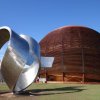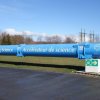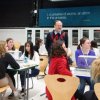From the 13th until the 15th of February 2020, our group of 34 students and three teachers went on an adventure to gather knowledge about the scientific field of particle physics at CERN, a government-funded research facility near Geneva, Switzerland.
The trip started in front of the Siegener Hallenbad where we, a group composed of students from 11th and 12th grade from a total of three different schools, met at 7:45AM to catch the bus to our hotel located in France, bordering Switzerland. After having loaded all of our luggage onto the bus and waiting for two tardy students, we were able to commence the drive, which was predicted to be about 11h-12h long.
All in all, the trip there went smoothly; we did not experience much traffic nor did anything concerning happen. The driver was changed after about an hour. During the drive, we had a total of three breaks, which each lasted more or less half an hour. During those breaks, we ate at the fast-food chains nearby, used the restroom and stretched.
What is remarkable is the fact that our group of students regathered on the bus on time after every break, so we could always drive off almost immediately. In consequence, the drive ended up being 10h long, instead of the estimated 11h-12h.
When we arrived, the winds were quite strong and it was raining, but we managed well and were able to unload our luggage and check into “ibis budget” without any difficulties. At the reception desk, we got to choose who we will be in a room with; there were boys’ and girls’ rooms. One of the ladder one’s rooms contained four girls, all of the other ones had three people staying in them, though. Everyone got a key, which was in the form of a card.
On the same day, after having dropped our bags off in our rooms and having recovered from the drive, we met up again with the teachers. They told us when we could expect to be eating breakfast the next day, then made us write down our and our parents’ phone numbers in case we wanted to use our free-time to go out. Many took up that chance to go to the nearest supermarket (“Carrefour”) to get some food for dinner; we would get breakfast at the hotel, but would need to take care of lunch and dinner ourselves. What was noticeable for the ones who went, was that the employees there only spoke French; it was a great opportunity to test one’s skills for those who had French at school.
The teachers had set the rule of every student having to be in their room at 10PM, so that is when the majority went back, ate some of the food they brought from home or bought at the store, showered, and got ready for bed. The teachers checked whether we were in our rooms at the given time.
The next day, many woke up at 7AM, because that is when breakfast was served. At around 8:30AM, everyone met up at the bus and we were driven to CERN. Once we entered the building with the reception desk, an employee gave us visitors’ badges with our names on them that we could sling around our shoulders. Then, we were split into three groups, each including one of our teachers and one tour-guide. Those tour-guides then gave us the “special” tour; the standard tour was meant for the next day.
One of the groups had an English-speaking guide, which was very enthusiastic about explaining what goes on at CERN. The other two groups had German-speaking ones. On our tour, they explained the general layout of CERN to us (e.g. the fact that there are many smaller accelerators that lead to bigger ones, so that the, in this case, protons could be accelerated more and more). The tour-guides also showed us one of the smaller accelerators named LEIR, where ions are accelerated. They explained to us how the beams of particles are focalised and moved in certain directions with the help of electromagnetic fields caused by currents running through magnets.
Before and during the tour, the tour-guides heavily encouraged us to ask questions during the explanations they would give us, so that we could learn more. When we did ask questions then, every single one was answered understandably, and thoroughly. They did not get lost in details, though. They got straight to the point.
Afterwards, we were given a break, where we could visit an exhibition named Universe of Particles, located in a huge wooden sphere, about the particles that had been at the beginning of the world (“Big Bang”) and how they interacted with each other as time went on. One could also view the very first particle accelerator (which was small and apparently had a production cost of only $25) (this is almost nothing compared to the cost of big accelerators today), as well as the computer that was used to create the world wide web (also known as the “internet”) at CERN.
We then returned to CERN to be split into two groups, one of which would first visit another exhibition named “microcosm” about the achievements of CERN and the ways their machinery works, whilst the other one would conduct an experiment called “cloud chamber”, where it was possible to make the decay of different particles (e.g. alpha-particles or electrons) visible to the human eye with the help of propanol and dry ice, as well as other materials.
Before we left, we had the chance to eat at the cafeteria at CERN, which was space-wise very broad and had all kinds of food. There, the staff spoke French to us. Many did not understand them, but the employees were very thoughtful about it, and so used a lot of gestures to explain things to us, like which menus we could pick etc.
At around 5PM, our time at CERN for the day came to an end. Our teachers managed to make a deal with the bus-driver; he would drive us to down-town Geneva, and then pick us up at 8PM. So that is what we did. In the city, we walked around in groups of three or more people. There were many activities one could do, like shopping, eating or just hanging around, which is what most did. Near the end, close to 8PM to say, everyone met up at the lake in the middle of the city to look at the city lights and the ducks swimming around. There was also a swan that would dip its head into the water at times to look for food.
The majority got to the bus at around 7:45PM. Those who did not get there yet, were called on their mobiles. Then, those students made an agreement with the teachers, which was actually already something the teachers said we could do if we wanted, beforehand: The students who wanted to stay in the city could stay there, so basically not go back with us in the bus at that time, but later with public transport instead and be back at the hotel by 10PM, though.
When we got back to the hotel, the majority of students hung out in each other’s rooms until 10PM, since that was when our teachers told us to go back to our rooms to rest for the next day.
The next morning, breakfast started again at around 7AM. Since it was our last day, we were supposed to load our luggage onto the bus and return our hotel keys at the reception desk by 8:30AM. Once that was done, we walked to CERN, which was about 3km away, so it did not take us long.
Once we arrived, we entered the reception building again, where an elderly man led us to a room with four flat screens at the front, conjoined to make one big screen. This is where the normal tour started.
The employee showed us a movie about CERN, which explained what they do (i.e. that they research particles and have discovered the Higgs boson in 2013). Afterwards, he went into the theoretical part of particle physics; he explained what kind of particles there are, and talked about the cosmic microwave background, as well as dark matter and dark energy and what they know and do not know about those topics.
After he was done explaining, he led us to a bus and we were split into two groups. The first group got to go with a university student from Mainz, Germany, writing his doctoral thesis at CERN, to the control centre of the accelerators, where they monitored everything. There, he explained each element of the accelerator in depth with the help of a screen behind him. The other group got another in-depth explanation of the functions of the accelerators as well, but with another employee.
After both groups had been well informed about the accelerators, we were driven to the place where the individual elements of the accelerators were tested. There, we were split into three groups, each receiving again one teacher and one tour-guide. The guides showed us the inside of accelerator pieces and explained their purpose to us. They even went into depth on the physics behind it, mentioning electrical and magnetic fields and forces, as well as the heat that can be created in the tubes caused by the electric current in the wires and the measures that they take to cool them.
Once this was done, all of the students and teachers gathered at the bus, and the drive home commenced. We had one long and one short break on the way home, until we finally arrived in Siegen at 10.30PM.
All in all, it was a great experience. The view from the hotel was gorgeous; dark mountains with contrasting snow, as well as flat fields with green grass. The personnel at CERN was more than qualified to explain the accelerators and their components to us. They also varied in gender, ages and nationality, showing the diversity of the people who work or study there.
The exhibitions were modern; there were touch-screens almost everywhere, where you could sometimes tap on questions of your choice to interact with the people being displayed. It was also interesting to observe how the exhibitions offered bilingual, trilingual or even multilingual explanations on different topics. You could tell that CERN is a place meant for everyone all around the world, so it was easier for us, being from another country, to feel like we could be a part of that.
This report was written in English to put emphasis on the fact that English is the language of science, which is something we got to experience first-hand on this field trip.







